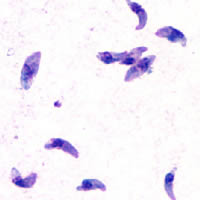Toxoplasma gondii
| Toxoplasma gondii | |
|---|---|
 |
|
| Giemsa stained T. gondii tachyzoites, 1000x magnification | |
| Scientific classification | |
| Domain: | Eukaryota |
| (unranked): | Sar |
| (unranked): | Alveolata |
| Phylum: | Apicomplexa |
| Class: | Conoidasida |
| Order: | Eucoccidiorida |
| Family: | Sarcocystidae |
| Subfamily: | Toxoplasmatinae |
| Genus: |
Toxoplasma Nicolle & Manceaux, 1909 |
| Binomial name | |
|
Toxoplasma gondii (Nicolle & Manceaux, 1908) Nicolle & Manceaux, 1909 |
|
Toxoplasma gondii (IPA /ˈtɒksoʊˌplæzmə ˈɡɒndi.aɪ/) is an obligate intracellular, parasitic alveolate that causes the disease toxoplasmosis. Found worldwide, T. gondii is capable of infecting virtually all warm-blooded animals, but felids such as domestic cats are the only known definitive hosts in which the parasite can undergo sexual reproduction.
In humans, T. gondii is one of the most common parasites in developed countries;serological studies estimate that 30–50% of the global population has been exposed to and may be chronically infected with T. gondii, although infection rates differ significantly from country to country. For example, previous estimates have shown the highest prevalence of persons infected to be in France, at 84%. Although mild, flu-like symptoms occasionally occur during the first few weeks following exposure, infection with T. gondii produces no readily observable symptoms in healthy human adults. This asymptomatic state of infection is referred to as a latent infection and has recently been associated with numerous subtle adverse or pathological behavioral alterations in humans. In infants, HIV/AIDS patients, and others with weakened immunity, infection can cause a serious and occasionally fatal illness, toxoplasmosis.
...
Wikipedia
